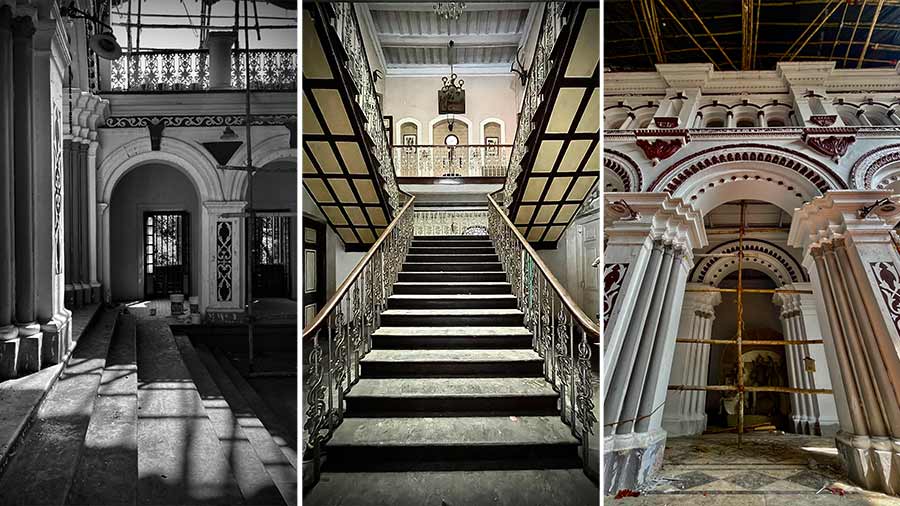Continued from here.
When one suggested ‘Law bari’ for my next column, the first question was ‘Which one?’
There are four, each built more than 175 years ago, when the family was one and created different properties for different sons, engaged in a range of businesses (gold, cotton, silk, sugar, salt, opium and writing instruments), created fabulous wealth and built a sprawling multi-acre asset for the family – in this case four large red mansions that have not only survived but are referenced by their respective codes (‘Bechu Chatterjee Street’ indicative of where the first one is located, ‘Pasteur’ indicative of a commercial establishment on the premises, ‘Ulto deekay Durga Charan’ indicative of the premises across ‘Pasteur’ and ‘Kailash Bose’ indicative of the address of the fourth).
Times changed. Neighbourhoods congested. Traffic turned noisier. But if there is a visible code that the Laha families (‘Law’ as per the angrezised version that has endured three quarters of a century even after the law makers left) still follow it is that their external facades are painted brick red. When you see two extensive façades of the same colour on Bidhan Sarani and turn the corner to encounter yet another extended frontage of the same colour on Bechu Chatterjee Street, you know it is the same people ‘owning’ that pantone combination on the shade card.
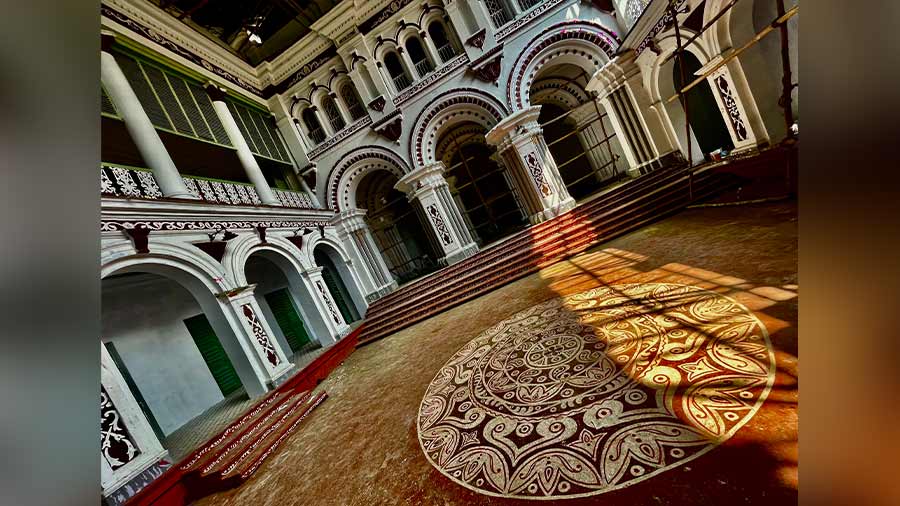
Glimpses of Laha bari (also below)
My Saturday morning is spent at the red Laha bari on Bechu Chatterjee Street (the backdrop for Piku, Parineeta, Barfi, Love Aaj Kal and Paglu). I expect a male family elder to sit me down with a clan book; I encounter Aparna Laha willing to converse instead. An hour into the conversation I understand why she is chief executive officer cum public relations officer deputed by the family to field interlopers (columnists, Instagrammers, tour guides, media, film directors, advertising agencies, heritage walkers) like me. She alternates between piling confectionaries on unsuspecting visitors, concurrently coordinating wall painting and inventorying essentials for The Big Week. She fields ignorant questions about family size (four on the immediate premises), staff strength (‘30 or 40’, giggling) and construction year (‘1832’).
It is a stiff morning; she doesn’t show it.
This Laha mansion façade is different: extensive frontage (my estimate 100 feet); two iron gates (ride in from one and exit from another in the pre-automobile age); pagoda-like verandah ceilings; extended balustrade of white grills.
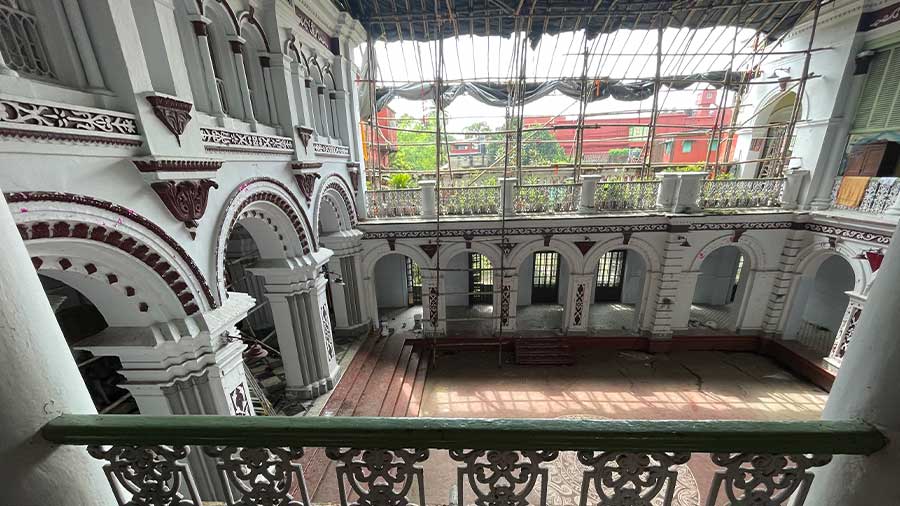
This is before Singhji the gateman comes back with ‘Didi bulaayein andar.’ The interior highlights: there are only three built sides of this property, the fourth having no living rooms or dancing halls, but largely open. This means that when one sits across Ms Laha in her office, the visitor’s direct line of sight behind her is not blocked by construction; one can sit in the long verandah adjoining her office and be lashed by the rain, soaked by the sun or submerged by the silence. In most Calcutta rajbaris, you need to sit in the ‘uthon’ for this direct engagement with nature (or whatever little of nature under a hazy Calcutta sky); this Laha bari first floor could probably be the sunniest and wettest in the city; it could also be among the quietest, insulated from street sounds. In the silence, the only time Ms Laha exercises the decibels is when her domestic help Maya drops a utensil and the kitchen reverberates.
Maya can justifiably blame the construction; the reverberation is the result of how Lahabari has been designed. The ceiling is 20 feet high, which means that two 2023 storeys can be neatly tucked into each existing level without anyone needing to stoop. Rooms are 250sq ft vintage, which means anyone walking through the premises a few times in a day can log 5,000 steps even before stepping out. The combination of space and height carries voices farther, which means that the moment one raises a voice, everyone gets the message. The walls are solid thick, which means that the interiors remain cool in summer and warm in winter.

I am under-apprenticed to understand what this kind of living means. Ms Laha decodes: ‘The construction is therapy for those who live inside. The high ceilings are good for mental balance. The large spaces have a calming influence. We believe that the space and height have influenced our way of thinking. When we check into a hotel – as we do when go on a vacation – my first reaction is ‘Chhoto ghor, ki kore thakbo?’’
The biggest Lahabari extravagance is unbuilt. The garden. To have one in this part of the city stands for raeesi. In a neighbourhood where residents need to take a bus to the maidan to feel the grass, I can visualise Laha generations bellowing from the bahar mahal balcony: ‘Baganey jaabi na….thanda lege jaabey!’ or ‘Ei bar ja phool phootaychhey…’ or ‘Boshlaam ektu baganey, bhalo laglo’ based on the nature of the season. I can ‘see’ the family members settling into garden corners for their morning doodh-chaa, sending out polite summons to the Mayas of the household: ‘Chaa baganey hobay! Cheeni kom!’ Or someone saying ‘Khoborer kaagoj jodi aashay, baganey pathiye diyo.’
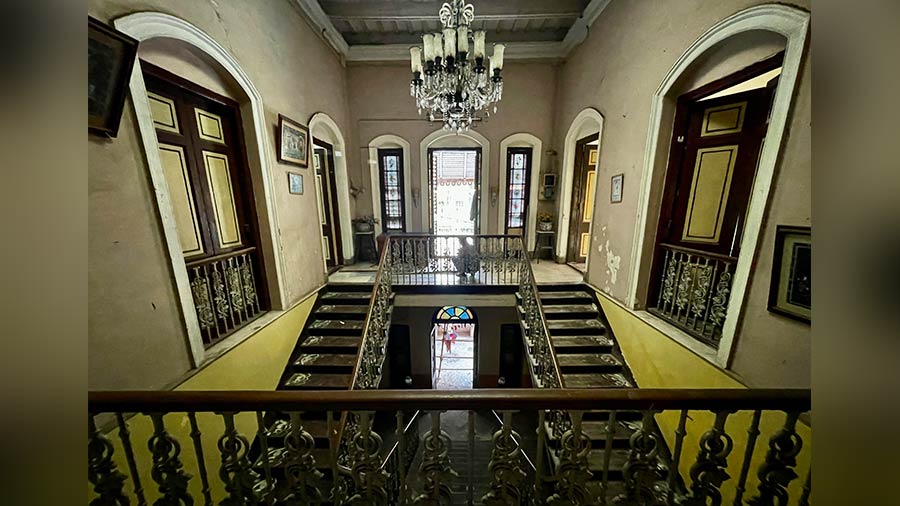
One would think that this fursat represents decadence in a modern world. Ms Saha introduces a different perspective: ‘What you see is leisure; what we see is responsibility. The maintenance of an apartment in a gated complex is child’s play; try maintaining a 190-year premises as large as this across the seasons in a joint family where all decisions have to be consensual and adjustment to the opinions of others needs to be perfected to an art. Besides, if you have an eye for cobwebs, dirt and dust – as would be standard in a polluted city – half your life can be spent in getting work allocated and then following up. This is not living in comfort; this is a full-time job!’
I am running out of time; I need to touch upon the impending Big Week. The family Durga Puja tradition is more than 250 years old; the puja in this Lahabari property is scheduled every six years by rotation; the family’s pujo fine print is different from other homes (which could come as a surprise to monotheists) without the underlying shroddha discounted in any way. There must have been a time when an ancestor said, ‘I will worship this way out of shroddha,’ nobody dissented and then it became family tradition.
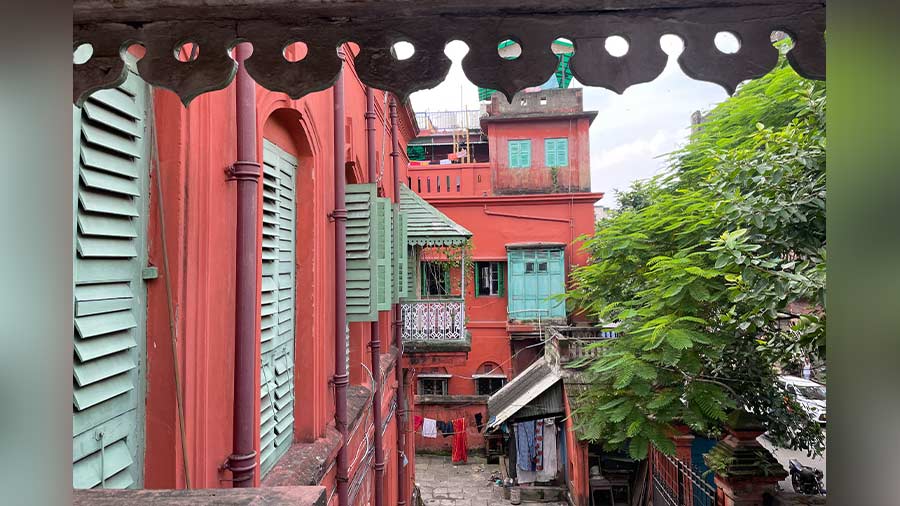
The typical signatures of this puja are reflected in the following details: the first paste of protima maati is drawn from the residential threshold of a prostituted woman (‘Only to show that our puja is inclusive and threads people of all social classes together’); a small Ganesh sculpted at the outset of idol creation is eventually placed inside a larger Ganesh; Durga here is but a daughter who has come to her maternal home and hence placed on her father Shiva’s lap (‘Horogauri’); since it is an emotional home coming there is no Mahishaasur or ten-armed Durga narrative in the iconography; Durga is rotated 360-degrees in the quadrangle before leaving to be immersed (‘So that she can view the entire house where she needs to return the following year’); the idol is never Matador-ed to the river but ‘hung’ with the ropes going under the idol and carried by 20 porters to Prasanna Coomar Tagore Ghat. I did a calculation when Ms Lala was not looking; the cost of getting Durga to the Ganges would be a good percentage of the budget of a number of Calcutta pujas.
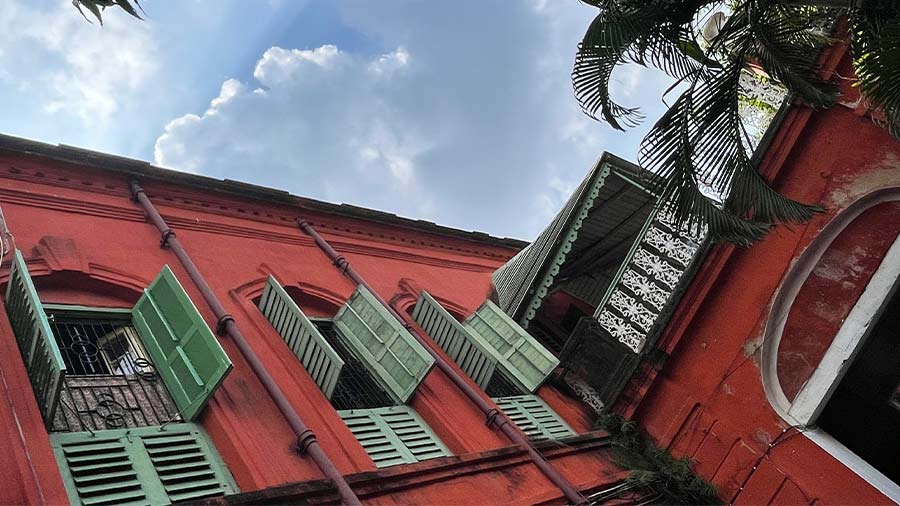
At Lahabari, the Durga Puja excitement builds every single day following Janmashtami; there is a Standard Operating Process of what needs to be done on which day by whom leading to Mahalaya (and after) inside the mind of Ms Laha (wonder why she does not write it down); there is a multi-member workforce to be cajoled to deliver on time (I can almost visualise the mild Ms Laha get fleetingly stern when the painter says ‘Aashte parlam na, jol jomay gechhey…’); tour operators call with attendance requests; the Lahabari Ashtami attendance crosses a thousand at peak and there are a number of people Ms Laha does not even recognise but does not turn away; the gates are generally open from 9am to 11pm with small breaks in between; Lahabari is almost like a walk-in period piece installation set.
Ms Laha emphasises the minutiae – no kaagoj – with four big points. One, she tears up each time the purohit recites ‘Ashvaddha shadhini swaha’ (What is difficult and impossible, Mother, you make easy). Two, the kola-bou snaan, marked by male members walking to the river. Three, the women of the family walking individually to Durga to whisper three words (‘Abar esho maa’) before she is finally taken away. Four, and here she points to my notebook to ensure that I do not miss a word, she says, ‘The biggest teaching is that the Puja and its traditions will endure, but we will not. We are mere visitors through this family and this property and the best we can do is to hand over what we have received to the generations that will follow.’
Life’s philosophy.
